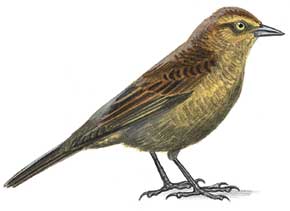Rusty blackbirds (Euphagus carolinus) nest in the far, far north, all the way to the tree line. They build large nests in trees alongside beaver ponds, muskeg swamps, and other watery habitats. In the winter, the birds flock in bottomland wetland forests in the southeast, sometimes mingling with larger flocks of grackles and red-winged blackbirds, but sometimes keeping to themselves. Unfortunately, this species appears to be in free-fall. The available data show a 90% decline since the 1960s. The cause of these plummeting numbers is not fully understood. Changes in the availability of forests on either the summer or winter grounds could be part of the explanation. Northern forests are being increasingly logged and disturbed, and climate change is drying them out and causing more frequent fire. Acid rain and mercury are also significant problems in the north. Here in the south, hardwood forests are cleared for agriculture, housing, and pine plantations. But neither of these habitat trends seems severe enough to account for the decline. Some as yet unknown form of contamination or disease might be involved. Or the decline might be rooted in the supply of the rusty blackbirds’ favorite foods, grasshoppers and other insects.
Source: David Haskell
Ramble, 20 November 2013
http://davidhaskell.wordpress.com/2013/11/20/rusty-blackbird/

- Log in to post comments
